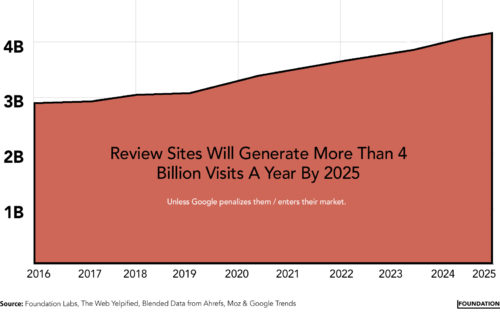One of the most difficult things in business today is to create an edge.
There are more businesses than ever before. There are more distractions than ever before. There are more virtual conferences, Zoom calls and blog posts than ever before.
Thus:
It’s becoming more and more difficult to capture the attention of your ideal customers.
This reality is…
This isn’t going to get easier any time soon.
No matter if you’re a CMO at one of the fastest growing SaaS companies or the founder of a 2 year old side project with ambitions to be the next big thing — That edge. That advantage. That slight differentiator that helps you win… Could very well be one of the most difficult things you pursue over the course of the next decade.
Over the last few months, I’ve talked about a handful of brands who have unlocked an edge on the back of content. I’ve discussed how Airbnb was able to create an SEO moat:
Airbnb has location templates across 128,317 different locations. These pages are generating more than 2.8M visits a month. Whether you’re looking for somewhere to stay in Manhattan or a place to stay in Rome — Airbnb has you covered. A quick Google search for “Airbnb in Manhattan” will take you to a page that looks very similar to the page you would find if you typed “Airbnb in Rome”.
And in another piece I talked about how Stripe used documentation & design to create an advantage over its competitors:
For most marketers, it’s the default to just focus on publishing blog posts. Stripe doesn’t do the expected; they invest in serving their developer audience. Stripe focuses on creating the technical docs that developers need to implement their solutions easily and go above and beyond to do it. They don’t just create plain old boring docs. They make documentation designed to please and rank with interactivity & more.
These are just two examples.
The freelancer marketplace Fiverr is another great example of a brand leveraging content to find its edge. At the end of lasts year, I took three videos that were uploaded to YouTube by influencers and sponsored by Fiverr to study the success of an influencer campaign they were running at the time. In just a few months, three of the 50+ Fiverr sponsored YouTube videos had generated more than 22 million views.
Not bad right?
Why do I bring all of this up?
It’s not to make you jealous of the creativity coming out of these companies.
It’s not to make you feel like you should do exactly what they do.
Instead… It’s quite the opposite.
All three of these companies took a different path:
- Airbnb: Massive Dynamic SEO-Driven Landing Pages
- Stripe: Hard To Scale But Beautifully Designed Documentation
- Fiverr: Entertaining B2B Influencer Marketing On YouTube
That’s what I want to get across.
I wish more marketers would stop trying to convince everyone that their specific marketing strategy is best for everyone else. It’s not that simple.
We all have:
Different competitors.
Different industries.
Different markets.
Different brands.
Different teams.
And as such…
We can’t all apply the same strategies and expect the same results.
A Michelin star restaurant can’t embrace discount prices like McDonalds and still win. Similarly, the focus on developer documentation might work wonders for Stripe but could be a bad decision for a completely other company. Don’t get me wrong:
Lessons can be learned from everyone.
But taking the exact same approach is usually a mistake.
You need to apply things under your own context.
Because at the end of the day:
SEO works. PPC works. Social media works. Digital PR works. ABM works. Content works. Email works. It all can work. There are a million ways to win.
The smart CMOs and Founders realize that and double down on what’s working well and create an advantage with that. Once they have it… That’s when they move on to the next channel and strategy to deepen their competitive moat.
So…
Don’t be afraid to find your own lane(s) & win.
You’ve got this.








